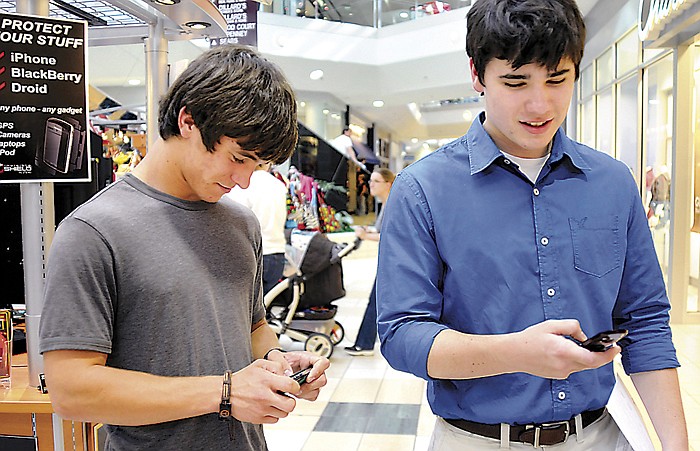Chaz Millican holds his lifeline to the world in his hand every day.
The 17-year-old Gordon Lee High School student is part of a growing majority of teens who use text messaging as their primary form of communication, surpassing phone calls and face-to-face conversation, according to a recent study by the Pew Research Center.
"I can be sitting here talking to you and still text," said Mr. Millican, of Chickamauga, Ga., between sending text messages while at Hamilton Place mall. "When I'm talking on the phone, I have to ignore everything else around me. But to text I can still pay attention."
More than half of those ages 12 to 17 sampled during the Pew study said they contacted friends daily via text. Just 33 percent contacted friends daily face-to-face outside school, the study showed.
Children also have steadily been getting cell phones at younger ages, with about 66 percent of teens receiving a phone before the age of 14, the study states.
Pam Glass, 44, said she got her now 16-year-old daughter, Mackenzie, a cell phone two years ago as a bargaining chip when she was unable to attend her eighth-grade dance.
"I really wasn't planning to get her one until she started driving," said Mrs. Glass, of Ooltewah. "I didn't get my son one until he was 16. I don't think there's a need for one until they start driving."
About 26 percent of all Americans ages 16 and 17 have texted while driving, and 43 percent say they talk on the phone while behind the wheel, the study states.
A bill that would have made Alabama the 20th state to ban texting while driving was killed last month, The Associated Press reported. Last year, a Tennessee law went into effect banning texting while driving, and similar legislation passed this year in Georgia's Senate.
Mrs. Glass said she was adamant with her daughter about obeying such laws when she began driving.
"She is absolutely not to text, at all, while she is driving," she said. "If she got caught, the phone would be taken from her. Also, if she ever got in a wreck, I would pull her texting records to make sure she wasn't texting -- that's absolutely a no-no."
PDF: Teens and Distracted Driving THEN & NOW* In 2004, 45 percent of 12- to 17-year-olds owned cell phones. Now 75 percent do.* In 2006, 51 percent of all teens used text messaging. Now 72 percent do.* In 2008, 38 percent of teens text messaged daily. Now 54 percent do.Source: Pew Research Center.
Texting in the classroom
Roads aren't the only unwanted place teens are pulling out their phones to text. Local teachers and administrators from middle school up to college say increased phone usage is becoming a hindrance in the classroom.
"We used to never deal with cell phone issues because they were so expensive and so rare," said Mike Culberson, principal of LaFayette Middle School in LaFayette, Ga. "Now it seems like every kid has a cell phone."
As a parent of two teenage children, Mr. Culberson said he recognizes the need for teens to have cell phones for safety purposes. But, as an educator, he knows that unregulated use can interfere with instruction.
Though students often use texts as a digital form of note-passing, Mr. Culberson said people would be surprised at who kids are texting most during the day.
"Believe it or not, a lot of the issues we deal with when students are texting in class, they're texting their own parents," he said.
Despite cell phones causing daily classroom distractions, 12th-grade English teacher Elizabeth Renneisen said the increased communication is having some positive effects.
"I think that any writing is good writing, is good practice," said Ms. Renneisen, who teaches at Tyner Academy in Chattanooga. "And they're writing more than they've ever been writing since I've been teaching. Now, they may not be writing in complete sentences, but they are still expressing themselves in written form."
Texting is becoming a popular way to communicate because it is a less risky way to express yourself, said Lester Ourth, a psychology professor at the University of Tennessee at Chattanooga.
"There is a big difference in engaging in communication where there has to be an immediate or fairly immediate response face-to-face," said Mr. Ourth, who teaches a course in friendship patterns. "Directly related to that is that things can be said texting that people are hesitant to say face-to-face -- and this certainly includes teens."
Dr. Ourth said texting facilitates, rather than hinders, communication processes, especially for men. Men are more likely to express feelings via text that they will not in face-to-face interactions, he said, especially when communicating with the opposite sex.
There are even signs that texting can create a closer relationship, especially when intimacy is involved, he said.
Several teenage boys said they are more willing to open up through texting than in person, but they draw distinctions about what is and isn't acceptable to talk about via text.
"It's not at all OK to break up with someone via text message," said Caleb Renegar, 17, a junior at Gordon Lee High School.
"There's a fine line talking with the opposite sex, especially if you're interested in them," said Alex Pilgrim, 17, also a junior at Gordon Lee High School. "Texting is not very personal, so it might seem like the wimpy thing to do ... but it makes it a lot easier."
Continue reading by following these links to related stories:
Article: Parents turn to texting, IM, e-mail to avoid kid ears
